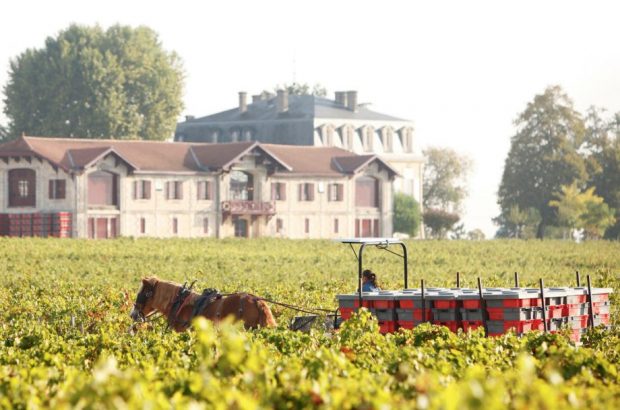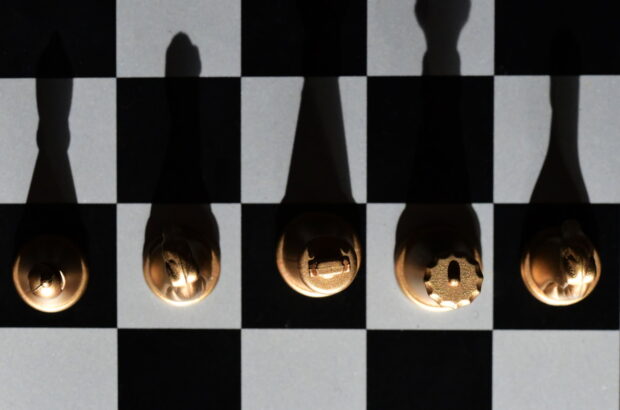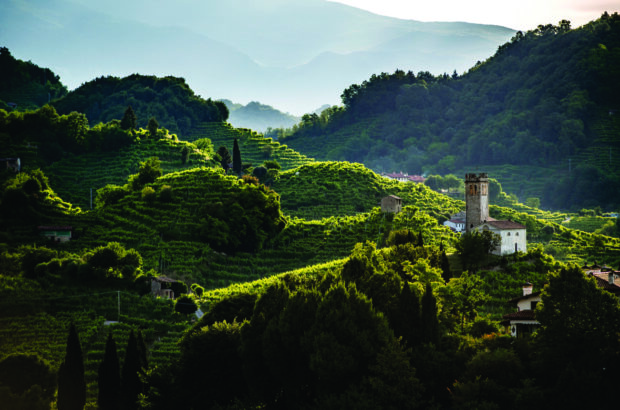When Moët & Chandon cellarmaster Benoît Gouez arrived in the Champagne region more than 20 years ago, rosé accounted for just 2- 3% of the house’s production. Since then, reflecting the boom in popularity of the rosé category in general, the importance of rosé at Moët has rocketed and it now accounts for 20% of the portfolio – in comparison, rosé accounts for 10% of production in the region as a whole.
In the early days of March, before lockdown began, Gouez flew into London to explain the role played by the still red base wines in Moët’s most important rosés: the non-vintage Imperial and the vintage wine – the current release being Grand Vintage Rosé 2012.
{"content":"PHA+SW4gY29tbW9uIHdpdGggbW9zdCBvdGhlciBDaGFtcGFnbmUgaG91c2VzLCBNb8OrdCBtYWtlcyBpdHMgcm9zw6kgYnkgYWRkaW5nIGEgcGVyY2VudGFnZSBvZiBzdGlsbCByZWQgd2luZSB0byB0aGUgd2hpdGUgYmxlbmQgYmVmb3JlIHRoZSBzZWNvbmQgZmVybWVudGF0aW9uIGluIGJvdHRsZS4gKFRoZSBvdGhlciwgbGVzcyBjb21tb24gbWV0aG9kIGlzIG1hY2VyYXRpb24uKSBCdXQgTW\/Dq3Qgc2V0cyBpdHNlbGYgYXBhcnQgd2hlbiBpdCBjb21lcyB0byB0aGUgbm9uLXZpbnRhZ2Ugcm9zw6ksIGNob29zaW5nIHRvIHVzZSB0aGVybW92aW5pZmljYXRpb24gaW4gaXRzIHN0aWxsIHJlZCB3aW5lIHByb2R1Y3Rpb24uPC9wPgo8cD4mIzgyMTY7V2UmIzgyMTc7cmUgdGhlIG9ubHkgaG91c2UgaW4gdGhlIHJlZ2lvbiB0byB1c2UgdGhpcyB0ZWNobmlxdWUgZm9yIG91ciByZWQgd2luZXMsJiM4MjE3OyBzYXlzIEdvdWV6LCB3aG8gYWRtaXRzIHRoYXQgaXQgdXNlZCB0byBiZSBhc3NvY2lhdGVkIHdpdGggbWVkaW9jcml0eS4gJiM4MjE2O0l0IHdhcyB1c2VkIGhpc3RvcmljYWxseSBhdCBNb8OrdCBwYXJ0bHkgdG8gZ3VhcmFudGVlIHJlZCB3aW5lIHByb2R1Y3Rpb24gZXZlbiB3aGVuIGNvbmRpdGlvbnMgd2VyZSBsZXNzIHRoYW4gaWRlYWwuIEl0IHdhcyBhYmFuZG9uZWQgaW4gdGhlIDE5OTBzLCBidXQgd2UgY2hvc2UgdG8gcmVpbnRyb2R1Y2UgaXQgdGhlIGZvbGxvd2luZyBkZWNhZGUsIGFkb3B0aW5nIGEgcHJlbWl1bSBhcHByb2FjaCBpbnN0ZWFkLiYjODIxNzs8L3A+CjxwPlRoZSB0aGVybW92aW5pZmljYXRpb24gaXMgdXNlZCBmb3IgdGhlIHRocmVlIHJvc8OpcyBpbiB0aGUgSW1wZXJpYWwgcmFuZ2Ug4oCTIHRoZSBOViwgdGhlIGRlbWktc2VjIE5lY3RhciBhbmQgdGhlIEltcGVyaWFsIEljZSwgY3JlYXRlZCB0byBiZSBlbmpveWVkIG92ZXIgaWNlIOKAkyBhbGwgdXNlIHRoZSBzYW1lIHN0aWxsIHJlZCBiYXNlIHdpbmU7IGl0JiM4MjE3O3MgdGhlIHdoaXRlIGJsZW5kIHRoYXQgdmFyaWVzLjwvcD4KPHA+PGRpdiBjbGFzcz0iYWQtY29udGFpbmVyIGFkLWNvbnRhaW5lci0tbW9iaWxlIj48ZGl2IGlkPSJwb3N0LWlubGluZS0yIiBjbGFzcz0iaXBjLWFkdmVydCI+PC9kaXY+PC9kaXY+PC9wPgo8cD5UaGUgc3RpbGwgcmVkIGJhc2Ugd2luZSBmb3IgdGhlIEdyYW5kIFZpbnRhZ2UgUm9zw6kgaXMgMTAwJSBQaW5vdCBOb2lyIGFuZCBpcyBzdGlsbCBtYWRlIHdpdGhvdXQgdGhlcm1vdmluaWZpY2F0aW9uLjwvcD4KPHA+VGhlIHRoZXJtb3ZpbmlmY2F0aW9uIHByb2Nlc3MgdG9kYXkgaW52b2x2ZXMgaGVhdGluZyB0aGUgcmVkIGdyYXBlcyB0byA3MMuaQywgdG8gZXhwbG9kZSB0aGUgY2VsbHMgYW5kIHJlbGVhc2UgdGhlIGNvbG91ciBhbmQgYXJvbWFzIGluIHRoZSBqdWljZSwgYmVmb3JlIGxvd2VyaW5nIHRoZSB0ZW1wZXJhdHVyZSBmb3IgYSBzaG9ydCAodHdvLWhvdXIpIG1hY2VyYXRpb24sIGFuZCBwcmVzc2luZyB0byBwcm9kdWNlIHJlZCBqdWljZS48L3A+CjxwPlRoZSBvYmplY3RpdmUgaXMgdG8gaGVscCBwcm92aWRlIGEgdmFyaWV0eSBvZiBzdHlsZXMsIGFuZCB0byBsaW1pdCB0aGUgdGFubmljIGV4dHJhY3Rpb24uICYjODIxNjtXZSB3YW50IHRoZSBub24tdmludGFnZSByb3PDqSB0byBiZSBlYXN5IHRvIGRyaW5rLCYjODIxNzsgYWRkcyBHb3VleiwgJiM4MjE2O2FuZCB0aGlzIGFsc28gZXhwbGFpbnMgd2h5IHdlIHVzZSBib3RoIFBpbm90cyAoTm9pciBhbmQgTWV1bmllcikgaW4gdGhlIG5vbi12aW50YWdlIHN0aWxsIHJlZCBiYXNlIHdpbmUuIE1vc3QgaG91c2VzIG9ubHkgdXNlIFBpbm90IE5vaXIsIGJ1dCB3ZSBmZWVsIHRoYXQgdGhlIE1ldW5pZXIgYWRkcyBhIHdlbGNvbWUgc3VwcGxlbmVzcy4mIzgyMTc7PC9wPgo8ZGl2IGNsYXNzPSJhZC1jb250YWluZXIgYWQtY29udGFpbmVyLS1tb2JpbGUiPjxkaXYgaWQ9InBvc3QtaW5saW5lLTMiIGNsYXNzPSJpcGMtYWR2ZXJ0Ij48L2Rpdj48L2Rpdj4KPHA+V2luZSBlZHVjYXRvciwgYXV0aG9yIGFuZCBjb25zdWx0YW50IFNhbGx5IEVhc3RvbiBNVyBleHBsYWlucyB3aHkgdGhlcm1vdmluaWZpY2F0aW9uIG1pZ2h0IGFwcGVhbCB0byBhIENoYW1wYWduZSBob3VzZSBwcm9kdWNpbmcgaGlnaCB2b2x1bWVzIG9mIHJvc8OpOiAmIzgyMTY7SXQgaXMgdHlwaWNhbGx5IGFzc29jaWF0ZWQgd2l0aCBsYXJnZXIgc2NhbGUgd2luZSBwcm9kdWN0aW9uIHRvIG1ha2UgZWFybHktZHJpbmtpbmcsIHByaW1hcnktZnJ1aXRmdWwsIHN0aWxsLCByZWQgd2luZXMgd2l0aCByaWNoIGNvbG91ciwgc29mdCB0YW5uaW4gdGV4dHVyZSBhbmQgbG93IGFzdHJpbmdlbmN5LiBJdCBpcyBxdWlja2VyIHRoYW4gYSB0cmFkaXRpb25hbCByZWQgdmluaWZpY2F0aW9uLCB0aG91Z2ggdGhlIGluaXRpYWwgY2FwaXRhbCBvdXRsYXkgY2FuIGJlIHNpemVhYmxlLjwvcD4KPHA+JiM4MjE2O0FzIGEgdGVjaG5pcXVlLCBpdCBpcyBqdXN0IG9uZSB3YXksIG9mIG1hbnksIHRvIGFpZCBicmVha2luZyBkb3duIGNlbGwgd2FsbHMgaW4gYmxhY2stIGdyYXBlIHNraW5zIHRvIHJlbGVhc2UgdGhlaXIgY29udGVudHMg4oCTIG1haW5seSBjb2xvdXIgYW5kIHRhbm5pbi4gVG90YWwgdGFubmluIGNvbmNlbnRyYXRpb24gaXMgdXN1YWxseSBsb3dlciB0aGFuIG90aGVyIG1hY2VyYXRpb24gdGVjaG5pcXVlcyBiZWNhdXNlLCB1bnVzdWFsbHkgaW4gcmVkIHdpbmUgcHJvZHVjdGlvbiwgdGhlIHRoZXJtb3ZpbmlmaWNhdGlvbiBqdWljZSBpcyB1c3VhbGx5IHByZXNzZWQgb2ZmIHRoZSBza2lucyBiZWZvcmUgZmVybWVudGF0aW9uIHN0YXJ0cy7CoCBXaGlsZSBjb2xvdXIgaXMgcmF0aGVyIHF1aWNrbHkgZXh0cmFjdGVkLCB0YW5uaW5zIHRha2UgbG9uZ2VyLCB0aHVzIGEgc2hvcnQgbWFjZXJhdGlvbiBicmluZ3MgY29sb3VyIGJ1dCBub3QgbXVjaCB0YW5uaWMgc3RydWN0dXJlLCB3aGljaCBmaXRzIHdlbGwgZm9yIENoYW1wYWduZSBwcm9kdWN0aW9uLiBBIGNoYWxsZW5nZSBtaWdodCBiZSB0byBleHRyYWN0IGVub3VnaCB0YW5uaW4gdG8gaGVscCBzdGFiaWxpc2UgdGhlIGNvbG91ciBvdmVyIHRpbWUuJiM4MjE3OzwvcD4KPGRpdiBjbGFzcz0iYWQtY29udGFpbmVyIGFkLWNvbnRhaW5lci0tbW9iaWxlIj48ZGl2IGlkPSJwb3N0LWlubGluZS00IiBjbGFzcz0iaXBjLWFkdmVydCI+PC9kaXY+PC9kaXY+CjxkaXYgY2xhc3M9ImluamVjdGlvbiI+PC9kaXY+CjxwPk1vw6t0JiM4MjE3O3MgcmVkIHdpbmVzIGFyZSBwcm9kdWNlZCBhdCB0d28gd2luZW1ha2luZyBmYWNpbGl0aWVzIGluIHRoZSByZWdpb24sIG9uZSBkZWRpY2F0ZWQgdG8gUGlub3QgTm9pciBhbmQgUGlub3QgTWV1bmllciBmcm9tIFZhbGzDqWUgZGUgbGEgTWFybmUsIHRoZSBvdGhlciByZXNlcnZlZCBmb3IgUGlub3QgTm9pciBmcm9tIEPDtHRlcyBkZXMgQmFyLiBBbmQgZXZlbiB0aG91Z2ggdGhlIEltcGVyaWFsIFJvc8OpIE5WIGNvbnRhaW5zIGp1c3QgOSUgb2YgcmVkIHdpbmUsIGFuZCB0aGUgR3JhbmQgVmludGFnZSBSb3PDqSAxMyUsIE1vw6t0IHByb2R1Y2VzIGFyb3VuZCA0MC01MCBkaWZmZXJlbnQgcmVkIGJhc2Ugd2luZXMgdG8gY2hvb3NlIGZyb20sIGdyb3dpbmcgZG91YmxlIHRoZSB2b2x1bWUgb2YgUGlub3QgTm9pciBncmFwZXMgdGhhdCBpdCBuZWVkcywgYW5kIGhhcnZlc3RpbmcgMTUwJSBvZiBpdHMgbmVlZHMsIHRvIGVuc3VyZSB0aGF0IGNob2ljZS4gJiM4MjE2O1dlIHBsYXkgd2l0aCBncmFwZSB2YXJpZXR5LCBvcmlnaW4gYW5kIHByb2Nlc3MgdG8gZ2VuZXJhdGUgZGl2ZXJzaXR5LCBhbmQgd2Ugd2FudCBhcyBtYW55IG51YW5jZXMgYXMgcG9zc2libGUgYXQgb3VyIGRpc3Bvc2FsLCYjODIxNzsgR291ZXogZXhwbGFpbnMuICYjODIxNjtXZSYjODIxNztyZSBsb29raW5nIGZvciBzb21lIGJhc2Ugd2luZXMgdGhhdCBhcmUgZnJlc2gsIGZydWl0eSBhbmQgc3VwcGxlOyBhbmQgb3RoZXJzIHdpdGggbW9yZSBjb25jZW50cmF0aW9uLiYjODIxNzs8L3A+CjxwPgo="}
Anne Krebiehl MW tasted the vintage and NV Moët & Chandon rosé for Decanter
{}
{"wineId":"38751","displayCase":"standard","paywall":true}
{"wineId":"38752","displayCase":"standard","paywall":true}
{}












